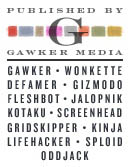“when blogs band together – a new hybrid form” – examining the phenomenon of multi-blog publications
 Few media outfits have ridden the blog phenomenon quite as cleverly as Gawker Media, the three-year-old brainchild of publisher Nick Denton. Gawker Media “takes the weblog format and applies the business model of a traditional magazine,” bringing together some of the web’s most popular rags, including Gizmodo, Lifehacker, Wonkette, and Fleshbot. With some of the highest traffic figures on the web (and the ad revenue that comes with them) it’s not a stretch to say that Gawker Media has become the Condé Nast of the blogosphere.
Few media outfits have ridden the blog phenomenon quite as cleverly as Gawker Media, the three-year-old brainchild of publisher Nick Denton. Gawker Media “takes the weblog format and applies the business model of a traditional magazine,” bringing together some of the web’s most popular rags, including Gizmodo, Lifehacker, Wonkette, and Fleshbot. With some of the highest traffic figures on the web (and the ad revenue that comes with them) it’s not a stretch to say that Gawker Media has become the Condé Nast of the blogosphere.
But unlike that goliath of the magazine world, Denton’s fledgling empire deals almost exclusively in second-hand material, and its staff is made up entirely of editors with not a writer to be found. Gawker blogs are of the pointer variety, directing readers to juicy finds around the world wide web with a splash of wit or snarky commentary. Of course, this is the formula for millions of weblogs – a couple of links with a bit of context. Denton’s coup has been to identify the best curatorial talents and collect them under a single umbrella.
The network’s flagship is, of course, Gawker, the addictive Manhattan gossip sheet, considered a must-read by society-watchers and scandal junkies. Defamer is its L.A. counterpart. Gawker Media bloggers actually receive a modest annual salary and are required to hit a minimum number of posts per day. Currently, there are 13 blogs in the Gawker tent, but the network is sure to expand. There’s even a Gawker observer blog, Gawkerist, whose author’s calculated ploy to capture Denton’s attention recently succeeded in securing him the editorship of Gawker’s urban travel blog, Gridskipper.
Gawker Media’s rise indicates that there is a broad demand for savvy, charismatic guides through the information blitz of the web. Success does not depend on getting readers to spend long stretches of time on one of the 13 sites, only on getting them to visit briefly, catching an ad or two in their peripheral vision, before getting bounced somewhere else. Gawker Media is a trampoline. It’s where people come to get bounced. This suggests that, though the author may enjoy primacy in the world of print, on the web it is more often the editor that counts.
if:book
A Project of the Institute for the Future of the Book
